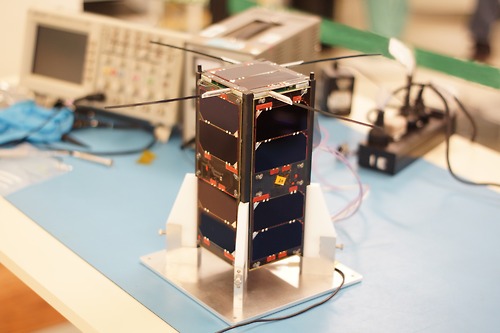An anonymous reader tipped us about two Argentinian satellites (satellite one, satellite two) that were sent in 2013 to space. What is interesting about them? They are both based on commercial off-the-shelf (COTS) components, and the team released the framework & flight computer software for their main platform (named cubesat, GitHub link). Gunter’s space page not only impresses us by showing the quantity of small/amateur satellites sent each month to space, but also lets us know that the hardware source files for CudeBug 1/2 are meant to be released. In the meantime we can only gather that they’re using a Texas Instruments TMS570 running FreeRTOS. Nevertheless, the two different web pages (in spanish and english) offer us a very interesting glimpse of what it takes to send an electronic project to space and how it later behaves.
You may also be interested in checking out ArduSat, a successful kickstarter campaign aimed at sending Arduino experiments in space.
















Checkout my satellite project on Hackaday. I will make it open and offer a devkit.
The launch costs will be reduced again by a factor of 8.
The launch costs for a single cubesat are still in the $50000 range, let´s squeeze them to under $10000
http://hackaday.io/project/986-TRSI-Satellite-%2F-Devkit
Going to break out my RTL dongle for some SDR goodness and see if I can’t pick these puppies up as they go past
What antenna are u using? Got good experience with self made eggbeater 2, the $50sat with only 100mW comes in well.
“Gunter’s space page not only impresses us by showing the quantity of small/amateur satellites sent each month to space”
Not to be mean here, but I don’t see how so many amateur sats going up is doing anything other than contributing to the space junk problem we have. That’s 35 satellites just on those two launches, and how many are going to be doing anything other than allowing the group to say “we put something in space”? If you’re going up on someone else’s launch vehicle then it’s not an achievement to get there. The achievement is in doing science once you’re up there.
Going through the list, I see:
– Nine with a camera (all essentially taking the same imagery).
– Seven acting as a radio relay/radio test source.
– Three that just report their own flight data.
– One that monitors the position/rotation of another satellite (which apparently cannot report its own flight data at all?)
– Five providing a service (though one is to a very specific group).
– Ten actually doing science (though one of which includes the ability to eject multiple other satellites).
So out of the 35, there’s 15 that are actually trying something new.
tl;dr: If you’re going to send something to space, make it do something useful once it’s up there. Try something new. Hell, send an Arduino up and use the bit-flipping properties of radiation to provide the world with an open freely-accessible source of entropy for their RNGs. Just, please, do something other than sticking another camera in orbit.
All somewhat valid comments, but these satellites are probably in VERY low earth orbit, so they will not live long, thus not likely to become a problem.
A reasonable counter-argument. I will admit that I don’t know what the expected lifetime of these sats is. I know one of them mentioned deorbiting at end of life, it wasn’t mentioned for the other ones on the linked site.
I think the average life in orbit for cubesats is 3-6 months, so they will not contribute to the debris problem.
Have You seen this?
http://www.interorbital.com/interorbital_03302014_003.htm
$4,000 to $12,500 per kilogram for launch seems kinda cheap.
Has anybody checked this out yet?
that’s similar to a DNEPR… which has flown multiple times.
This is a much cooler satellite: http://space.skyrocket.de/doc_sdat/wren.htm. They’re using to test tiny pulsed plasma thrusters.
When I want something in space I just ask a HaD winner to put it in his/her luggage :)
Found this gem in their code:
int app_main( void )
{
…
// TODO
return 69;
}